The House Crow (Corvus splendens) is a ubiquitous and adaptable bird species in Asia’s urban and rural landscapes.
With its distinctive black plumage and raucous calls, the House Crow is a familiar sight in cities, where it scavenges for food scraps and nests on buildings and trees.
Known for its intelligence, problem-solving abilities, and communal roosting behavior, the House Crow has forged a unique relationship with humans, simultaneously revered and reviled for its adaptability and resourcefulness.
This enigmatic bird species serves as a reminder of the complex interactions between wildlife and human environments in shaping urban ecosystems.
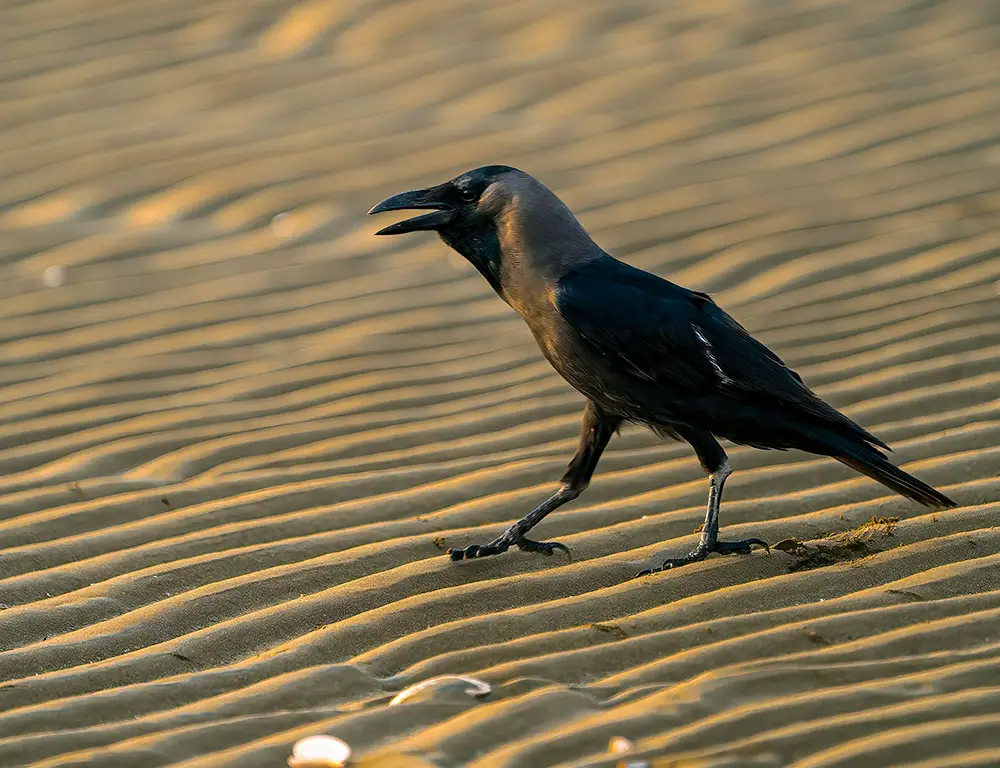
Characteristics Of House Crow
The House Crow (Corvus splendens) is a highly adaptable and intelligent bird species across various regions.
Here are some common characteristics of the House Crow:
Physical Characteristics
The House Crow (Corvus splendens) is a common bird known for its adaptability and intelligence.
Here are seven physical characteristics of the House Crow:
Size
House Crows are medium-sized birds, measuring about 40-42 centimeters long, with a wingspan of around 85-100 centimeters. They have a robust build and relatively short legs compared to other crow species.
Coloration
These crows have predominantly black plumage with a glossy black that can appear bluish or purplish in certain lighting conditions. Their feathers may exhibit radiance, especially on the wings and tail.
Beak
The House Crow’s beak is sturdy and slightly curved, ideal for grasping and manipulating food items. It is black and well-suited for a scavenging diet.
Eyes
Their eyes are small and dark, providing excellent vision for detecting food and potential threats. Their keen eyesight aids in scavenging and foraging activities.
Voice
House Crows are known for their loud and raucous calls, which can vary from harsh caws to more musical notes. They use vocalizations for communication within their social groups and to assert dominance.
Tail
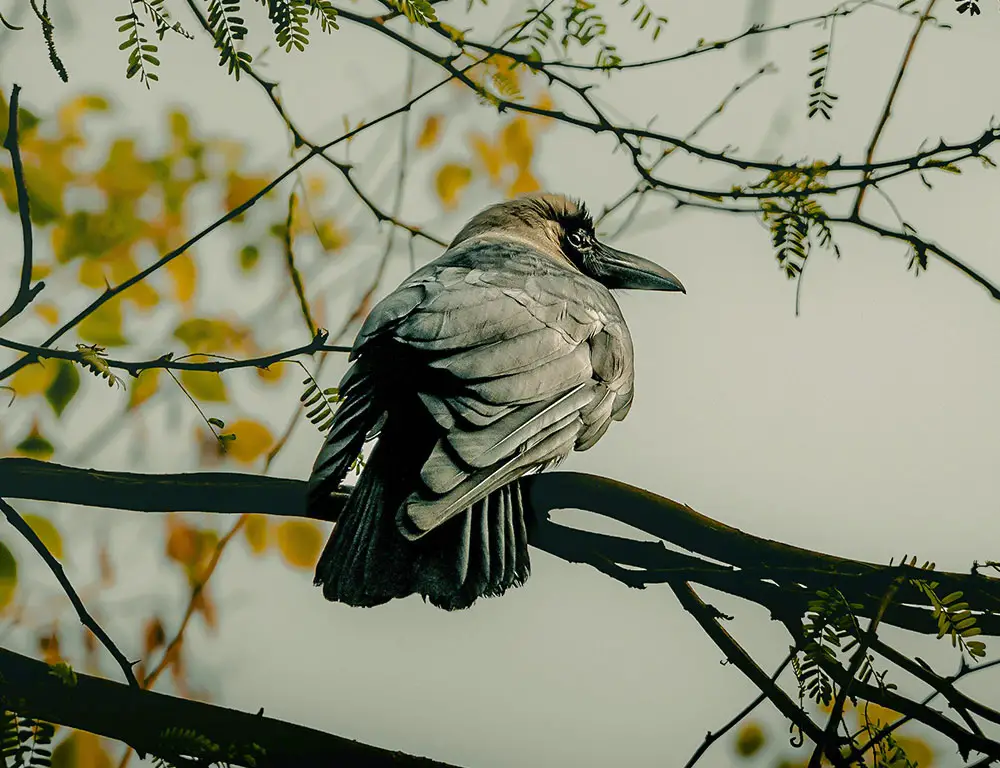
The House Crow’s tail is square-shaped and relatively short compared to its body size. It helps with balance and maneuverability during flight and perching.
Feet
Their feet are strong and adapted for perching and walking on the ground. They have sharp claws that enable them to grip onto branches and other surfaces securely.
Distribution And Habitat
House Crows are widespread throughout Asia, with populations thriving in urban, suburban, and rural environments. They are often found near human settlements, where they scavenge for food and build nests on buildings and trees.
Subspecies
While the House Crow is a monotypic species, meaning it does not have a recognized subspecies, there may be slight variations in appearance and behavior across different geographical regions.
Behavior And Ecology
House Crows are opportunistic feeders, consuming a diverse diet that includes insects, fruits, grains, and human food scraps. They are known for their bold and gregarious nature, often forming large social groups and exhibiting complex social behaviors.
National Bird Of The Philippines
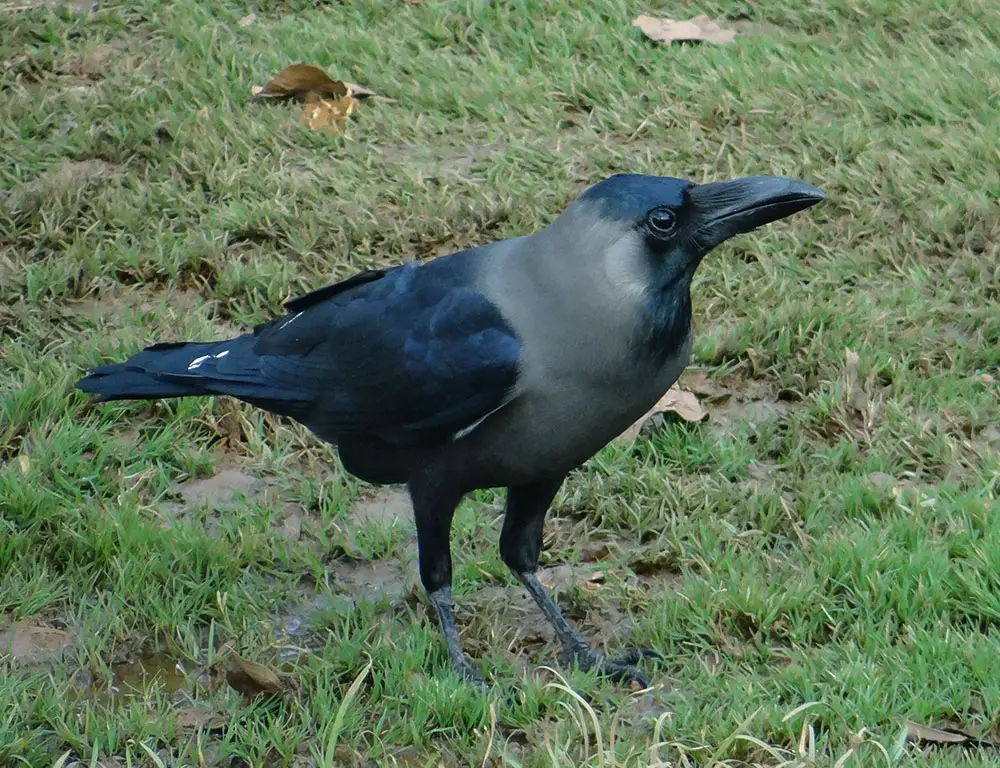
The House Crow was designated as the national bird of the Philippines until 1995, symbolizing the country’s rich avian diversity.
Invasive Species
House Crows are considered invasive in some regions due to their ability to outcompete native bird species, disrupt ecosystems, and cause nuisance to humans.
Roosting
House Crows typically roost in large communal groups, congregating in trees, rooftops, and other elevated structures. These roosting sites protect from predators and serve as social gathering spots.
Relationship To Humans
House Crows have a complex relationship with humans. While they are often regarded as pests due to their scavenging habits and potential for crop damage, they also control insect populations and are sometimes considered beneficial.
Reproduction
House Crows typically breed in monogamous pairs, building cup-shaped nests in trees, buildings, or other elevated structures. They lay a clutch of eggs, which both parents incubate until they hatch.
Protection/Threats/Status
While House Crows are not currently considered globally threatened, they face various threats, including habitat loss, human persecution, and exposure to toxins.
Their status varies across different regions depending on local conservation efforts and threats.
The House Crow’s adaptability, social behavior, and close association with human habitats make it a fascinating and sometimes controversial bird species, highlighting the complex interactions between wildlife and human societies.
Taxonomy
Here’s the taxonomy table for the House Crow (Corvus splendens):
| Taxonomy Level | Classification |
| Kingdom | Animalia |
| Phylum | Chordata |
| Class | Aves |
| Order | Passeriformes |
| Family | Corvidae |
| Genus | Corvus |
| Species | Corvus splendens |
Nesting Habit
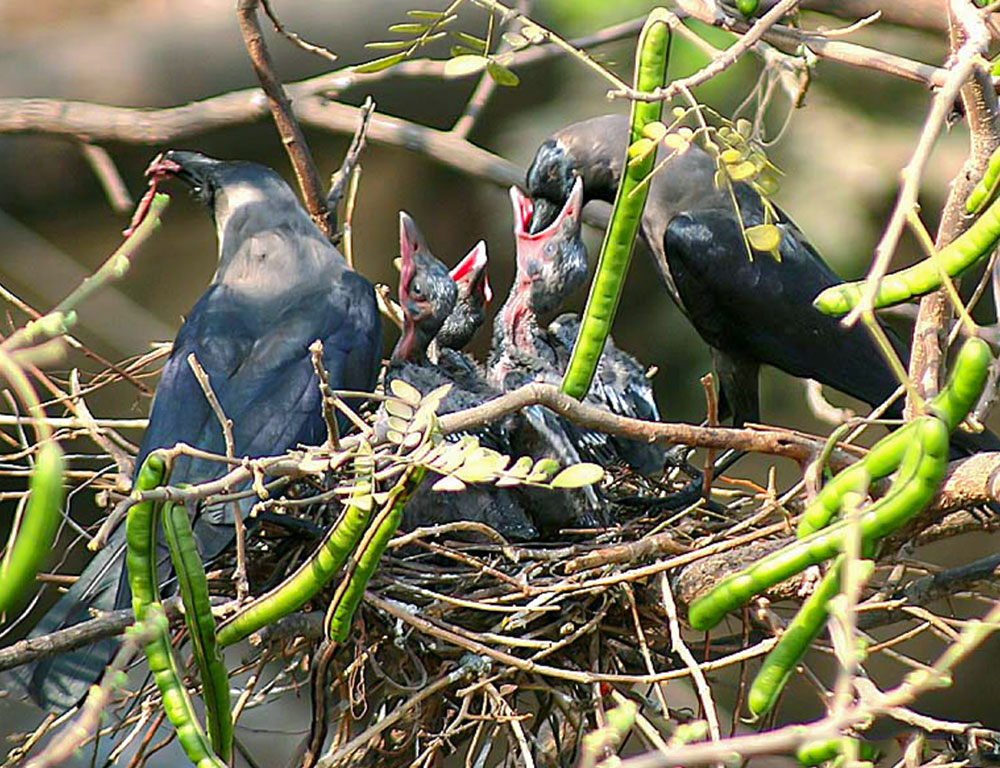
Here’s a table outlining the nesting habits of the House Crow:
| Nesting Habit | Description |
| Nest Location | House Crows build their nests in various locations, including trees, buildings, utility poles, and other structures. |
| Nest Materials | The nests are constructed from twigs, branches, grass, and other plant materials, often lined with softer feathers, cloth, or paper. |
| Nest Construction | House Crows are skilled builders constructing large, bulky nests with cup-shaped interiors. Both male and female birds participate in nest-building. |
| Breeding Season | Breeding season varies depending on the location, with House Crows often breeding from late winter to early summer. |
| Egg Laying | The female House Crow lays a clutch of 3-6 eggs, incubating for 18-20 days. |
| Chick Rearing | Both parents participate in feeding and caring for the chicks, which fledge after about 4-6 weeks from hatching. |
| Nesting Success | Success rates vary, but House Crows are adaptable and resilient breeders, often successfully raising multiple broods each year. |
Ranging Map
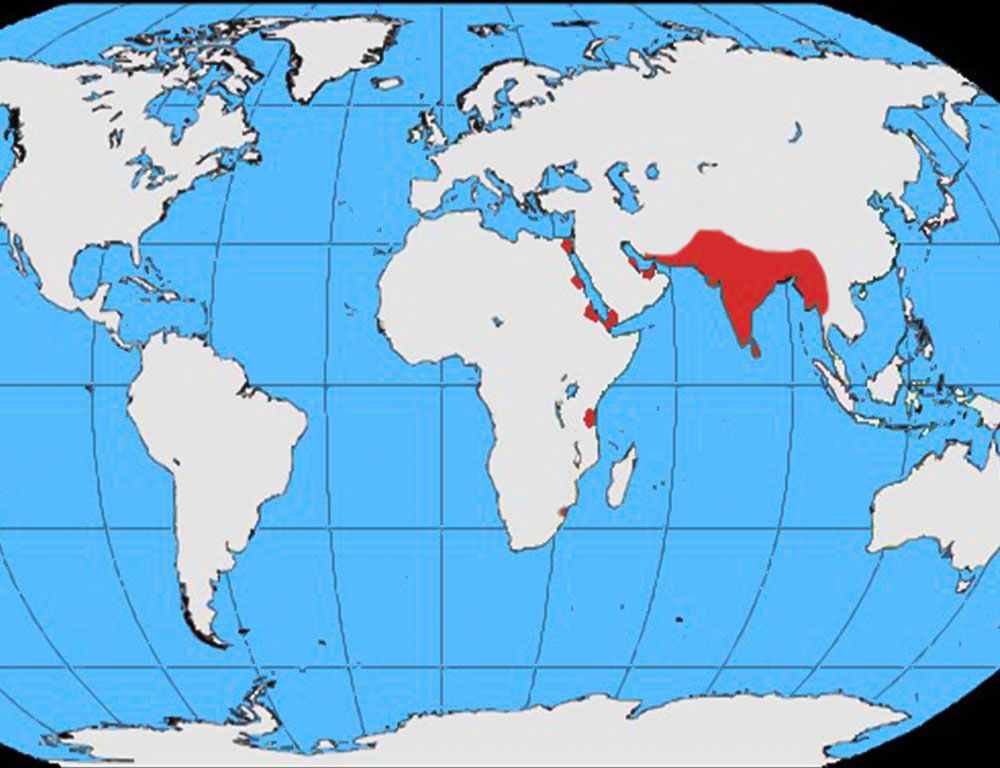
The House Crow (Corvus splendens) is widely distributed across Asia, with urban, suburban, and rural populations.
While the House Crow’s native range extends from the Indian subcontinent to Southeast Asia, human activities such as urbanization and habitat alteration have facilitated its spread to other parts of Asia and beyond.
In urban areas, House Crows are commonly found nesting on buildings, rooftops, and utility poles, scavenging for food scraps in streets and garbage dumps.
They also inhabit parks, gardens, and agricultural areas, where they forage for insects, grains, and fruits.
House Crows may nest in trees or shrubs near agricultural fields, feeding on crops and small animals in rural environments. Their ability to exploit various food sources and adapt to diverse habitats has contributed to their success as a species.
What Is The Local Name Of The House Crow?
The House Crow (Corvus splendens) is known by various local names, reflecting its widespread distribution and close association with human settlements.
In India, it is commonly referred to as the “House Crow” or simply “Crow.” In other parts of Asia, it may be known by names such as “Indian Crow,” “Greynecked Crow,” or “Colombo Crow.”
Local names often reflect the bird’s ubiquitous presence in urban and rural areas, where it is frequently encountered scavenging for food scraps, perching on rooftops, and nesting on buildings.
Despite being considered a pest in some regions due to its scavenging habits and potential for crop damage, the House Crow is also celebrated for its intelligence, adaptability, and role in controlling insect populations.
Its local names reflect the diverse cultural perceptions and interactions with humans that have shaped its identity across different communities and landscapes.
7 Interesting Facts About House Crow
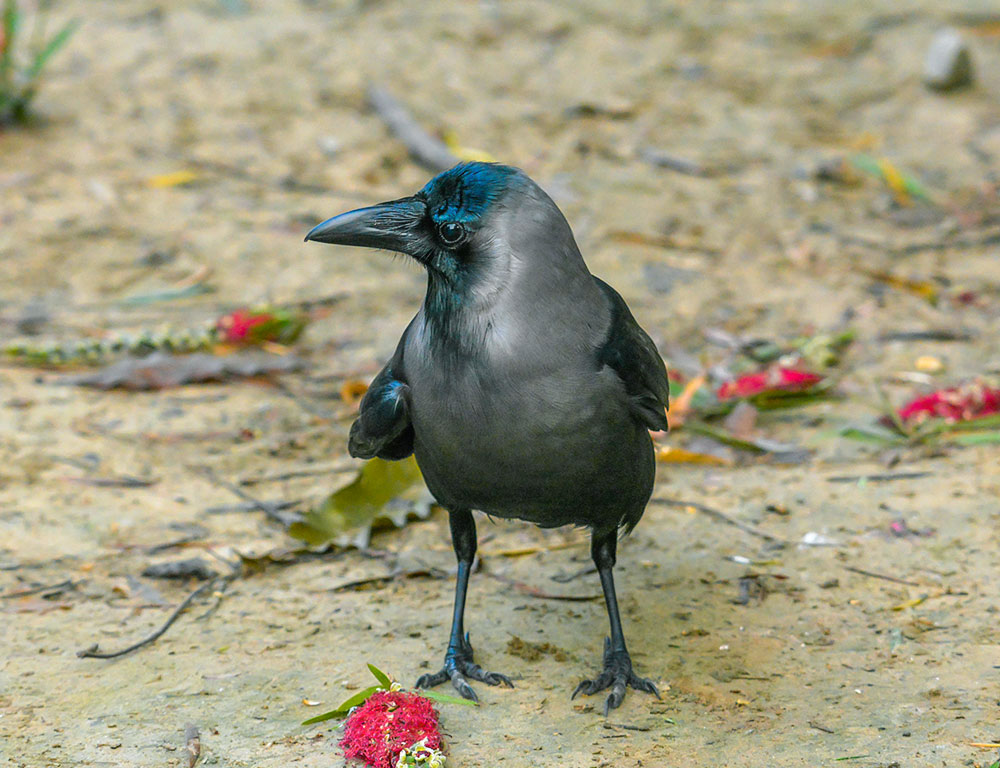
Here are 7 exciting Facts About House Crow:
1. Urban Adaptability
House Crows are highly adaptable birds, thriving in urban environments where they scavenge for food in streets, garbage dumps, and open spaces. Their ability to exploit human-altered landscapes has led to widespread distribution across cities and towns.
2. Intelligence
House Crows are known for their intelligence and problem-solving abilities. They can quickly learn to associate humans with food sources and have been observed using tools to extract food from hard-to-reach places.
3. Communal Roosting
House Crows often roost in large communal groups, congregating in trees, buildings, and other elevated structures. These roosting sites protect from predators and serve as social gathering spots.
4. Mimicry
House Crows are accomplished mimics capable of imitating a wide range of sounds, including human speech, other bird calls, and mechanical noises. They use mimicry to communicate within their social groups and deceive potential threats.
5. Adaptive Diet
House Crows are omnivorous birds, feeding on diverse food items, including insects, fruits, grains, small mammals, and carrion. They are opportunistic feeders, exploiting whatever food resources are available in their environment.
6. Colonial Nesting
House Crows often nest in colonies, building large, bulky nests in trees, buildings, or other elevated structures. They exhibit cooperative breeding behavior, with multiple adults helping to raise and defend the young.
7. Cultural Significance
In many cultures, House Crows hold cultural significance, featuring prominently in folklore, myths, and superstitions.
While they are often regarded as pests in urban areas, they are revered in some traditions as symbols of intelligence, adaptability, and survival.
Conclusion
The House Crow stands as a testament to the resilience and adaptability of avian species in the face of urbanization and habitat alteration.
Its ability to thrive in diverse environments, from bustling cities to rural villages, reflects its remarkable capacity to coexist alongside human populations.
While it may be regarded as a nuisance in some areas due to its scavenging habits, the House Crow also plays a vital role in controlling insect populations and contributing to ecosystem dynamics.
As cities expand and human-wildlife interactions intensify, understanding and appreciating the ecological significance of the House Crow becomes ever more crucial in promoting harmonious coexistence between humans and wildlife.